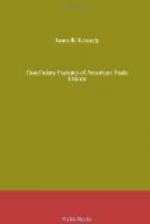The following table shows the minimum and the maximum amounts paid by the several brotherhoods:
Minimum Maximum
Brotherhoods. Amount.
Amount.
Brotherhood of Locomotive Engineers ... $1500 $4500 Order of Railway Conductors ........... 1000 3000 Brotherhood of Locomotive Firemen ..... 1500 3000 Brotherhood of Railroad Trainmen ...... 500 1350 Order of Railroad Telegraphers ........ 300 1000 Switchmen’s Union ..................... 600 1200 Maintenance-of-Way Employees .......... 500 1000 Letter Carriers’ Association[76] ...... 1000 3000
[Footnote 76: Under a unique system, known as the “Post Mortem Deduction” scheme, the actual value of a certificate of the Letter Carriers’ Association at date of issue is fifteen per cent. less than its face value plus the amount of one assessment, and the value of the certificate does not become equal to its face value until the member has paid assessments equal to fifteen per cent. of the face amount (Constitution, 1904, pp. 67-68).]
Originally, except in the case of the Letter Carriers, the maximum amounts paid were much lower than at present. As the membership increased, a greater benefit was paid. In 1887 the Conductors’ maximum insurance was $2500, and in 1888 the Firemen’s, the Trainmen’s, and the Switchmen’s was raised to $1500, $1000 and $800, respectively. Each of the railway organizations has since raised the maximum; the Engineers to $4500 in 1892; the Conductors to $5000 in 1893, reduced since 1899 to $3000; the Firemen to $3000 in 1903; the Trainmen to $1350 in 1903; and the Switchmen to $1200 in 1901. While the Engineers, the Conductors, and the Firemen offer insurance in relatively large amounts, only a small per cent. of the membership take out certificates for the larger sums. On June 30, 1904, of the 54,434 Firemen, 43,228 carried $1500 certificates, while only 717 carried $2000 certificates, and 824, $3000 certificates.[77] On November 1, 1904, of the 41,124 Engineers, 24,187 carried $1500, and 10,337 and 1602 carried $3000 and $4500, respectively.[78] In each of these organizations the $1500 certificates are thus in greatest demand. The rule restricting the amount that members over forty-five years of age may take lessens the number of policies for larger sums, but it is evident that the great majority of members in these unions do not care to insure for more than $1500. The Letter Carriers are an exception to this rule. The report of the Chief Collector for December 1, 1905, shows that out of 5284 insurance certificates in force there were 473 $1000 certificates, 386 $1500 certificates, 541 $2000 certificates, and 3884 $3000 certificates.[79]
[Footnote 77: Report of W.S. Carter, Grand Secretary-Treasurer, June 30,1904.]
[Footnote 78: Locomotive Engineers’ Journal, Vol. 38, p. 966.]
[Footnote 79: Postal Record, Vol. 19, p. 10.]




